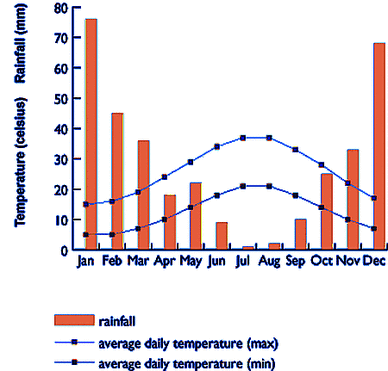When one contemplates a Mediterranean climate, the imagery conjured often flits between sun-drenched terraces adorned with vibrant bougainvillea and olive trees swaying softly in the balmy sea breeze. This climatic ballet unfolds in regions where the sun plays a predominant role in shaping ecosystems, landscapes, and even cultures. The Mediterranean climate, characterized by its unique seasonal contrasts, enables an array of flora and fauna to thrive under the benevolent sun. Exploring this climate unveils not just a meteorological phenomenon, but an intricate tapestry of life.
To fully appreciate what a Mediterranean climate encompasses, it’s essential to traverse its key characteristics and understand its global implications. The sun reigns supreme here, and its influence crafts a world that marries warmth and companionship, where nature flourishes in a symphony of bright colors and scents.
Defining the Mediterranean Climate: A Warm Embrace
The Mediterranean climate flourishes in certain subtropical regions of the world, notably around the Mediterranean Sea, but also extends to locales such as California, parts of Chile, South Australia, and South Africa. It emanates from long, hot, and dry summers juxtaposed with mild, wetter winters—the perfect seasoning for diverse ecosystems. These regions typically experience an average annual precipitation of about 15 to 40 inches, significantly concentrated in the cooler months, allowing the earth to breathe in the warmth of summer.
This climate is essentially the result of the meeting of oceanic and continental weather systems. The warm air from the sea dances with cooler air from the land, giving rise to peculiar weather patterns. It is here that summer temperatures can ascend to sultry heights, often hovering around 86°F (30°C) or higher, while winter temperatures remain refreshingly moderate, rarely dipping below 40°F (4°C). Such a climate acts as an alchemist, transforming regions into vibrant havens where horticulture flourishes.
Flora and Fauna: Nature’s Palette in Bloom
The Mediterranean climate is an artist’s palette, overflowing with colors and textures. The foliage here is tenacious, characterized by evergreen trees, aromatic shrubs, and an abundance of flowering plants. The hardy, drought-resistant flora such as olive, cypress, and cork oak thrive in this environment, showcasing remarkable adaptability. Meanwhile, the extensive use of terms like “maquis” or “garrigue,” refers to the rich underbrush that fills the landscape, composed of shrubby vegetation that manages to survive the relentless summer heat.
Beyond flora, fauna finds refuge within these unique habitats. Diverse species of birds, mammals, and reptiles have adapted to the seasonal rhythms of the Mediterranean climate. Migratory birds flock to these regions during milder months, drawn by the bountiful food supply, while indigenous species embody resilience, evolving unique survival strategies to endure the summer’s parched embrace.
The Ecosystem’s Balancing Act: Between Flood and Drought
One of the most intriguing aspects of the Mediterranean climate is its central role in environmental balance. The dichotomy between the wet winters and dry summers presents a fascinating juxtaposition. During winter, the regions receive most of their rainfall, rejuvenating the earth and replenishing water sources. However, this abundance can also lead to flash floods, a reminder of nature’s capriciousness.
Unique ecosystems flourished within this climate underscore a profound interconnectedness. This interdependence, however, is facing rising threats such as urbanization, climate change, and invasive species. As human activity escalates, the delicate equilibrium that defines the Mediterranean climate is put at risk, threatening not only its ecological integrity but also the cultural heritage that has evolved alongside it.
Why Is Mediterranean Climate So Inviting? The Charms of Living and Visiting
The Mediterranean climate extends far beyond its scientific classification; it welcomes an enriching lifestyle. Endless sunshine beckons outdoor activities, from languorous picnics to energetic hikes, nurturing a camaraderie with both nature and fellow inhabitants. Its longstanding cultural intertwining with agriculture—especially the growing of grapes and olives—creates an emotional bond with the land. The renowned Mediterranean diet, famed for its health benefits, celebrates this way of life, emphasizing fresh produce, healthy fats, and artisan craftsmanship.
Moreover, the Mediterranean region has become synonymous with leisure. The vibrant cities and laid-back villages exude a charm enhanced by local cuisines, historic architecture, and a welcoming populace. From sun-soaked beaches to quaint vineyards, every corner of this climate invites exploration, fostering a deep appreciation for the harmonious blend of natural beauty and cultural richness.
Conclusion: A Remedial Legacy
The Mediterranean climate transcends mere geographical boundaries. It epitomizes resilience, adaptability, and the art of living well. As the rhythms of nature continue to change with global dynamics, cherishing this climatic phenomenon becomes imperative. The sunny allure and mild temperament of these regions offer a model of ecological balance worth emulating, nurturing a legacy that cultivates harmony, not only among flora and fauna but between humanity and the natural world. In the tapestry of climatic diversity, the Mediterranean climate stands as a testament to life that thrives against the odds—a celebration of sunshine, warmth, and indomitable spirit.








